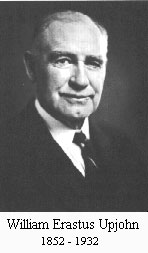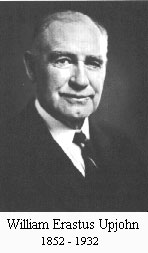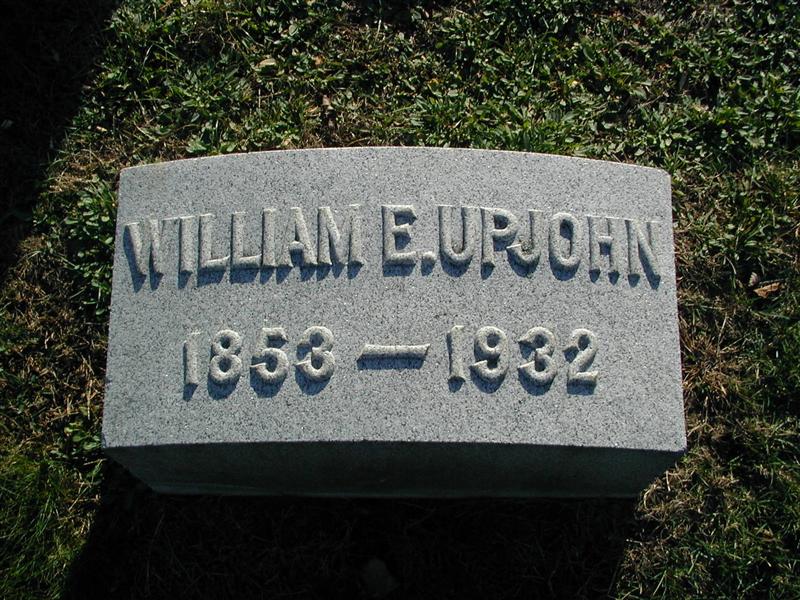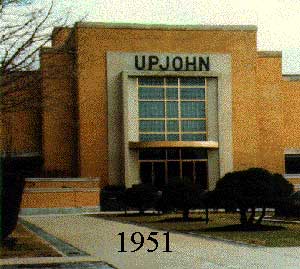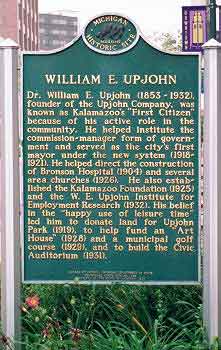Hastings, MI. W.E. met his future wife, Rachel Babcock, while working as a clerk in her father’s pharmacy. They married the day before Christmas in 1878 and produced 5 children. In 1880 WE started his own practice in Hastings and began working on a machine to improve the quality and manufacture of pills.In his first few years of practicing rural medicine, W. E.'s interest slowly changed from that of a physician to working on an innovative, new pill making process. In 1883 he began producing pills in the attic of his home in Hastings and in 1885 he received a patent (no. 312,041) for his machine that produced "friable" pills, (ie those that easily crumble and dissolve). At the time most pills had hard coatings that often did not dissolve in the stomach - they simply passed straight through! Instead of forming them from paste, as was the usual method then, he built them up from "starter" particles in a revolving pan, by alternately spraying the starter particles with moistening
agents and sifting powdered drugs onto them. This was to be a milestone in pharma-ceutical manufacturing because for the first time, using this new process, "friable"pills (whose dosage was also controllable) could be mass
produced. Production soon moved from his attic to the upper floor of an abandoned Hastings feed mill. W.E., then aged 32, moved his family to Kalamazoo and together with his brothers, Henry, Frederick Lawrence and James Townley# established The Upjohn Pill and Granule Company late in 1885. Thay started in the basement of the Upjohn Block, a block of stores with apartments and offices above, which Dr. Henry had had put up near Burdick Street a few years before. The following year the new company had a building of its own on a site behind the Upjohn block (on Farmer's Alley) and by the end of 1886 it employed 12 people and manufactured 186 different "medicinal formulas", compounded from 56 different drugs: 30 botanicals, 20 chemicals, 5 alkaloids and 1 glucoside. The first year's sales were an impressive $50,000! Since the friable pill was capable of being crushed with the press of a thumb,an illustration of this (using WE's own thumb) became the company’s trade-mark. Henry sadly died
on 2nd January 1887 and in 1888 the company moved again, this time to Lovell Street, where it remained for over 100 years. It was to become Kalamazoo's largest employer for many years. Upjohn sales reached $132,500 in 1890.
In 1902 the name was shortened to "The Upjohn Company" and it was becoming very successful. However in 1909, after major disagreements and arguments between the 3
brothers, W.E. bought the other 2 out and took sole control of the Company. In 1920 W.E.turned over the daily operations of the Company to others, but he continued to maintain close control over the business until his death. In 1925, the year he established the Kalamazoo Foundation, he entered semi-retirement while his son (William) Harold Upjohn (born 28th January 1884), who joined the business in 1907, had risen to the post of general manager and then vice president. Tragedy struck again with the untimely death of Harold on 15th October 1928 and W.E. was forced to return to active management until a successor
could be found. His nephew, Dr. Lawrence Northcote Upjohn* became his successor in 1932.The death of WILLIAM ERASTUS UPJOHN of a heart attack at age 79 on October 18,
1932, at his beloved summer home Brook Lodge (where he had so enjoyed cultivating plants in his spare time), left the community in mourning. Called by many "Kalamazoo's
First Citizen", flags flew at half-mast when the news was announced. All businesses and schools in the city closed for the hour of his funeral. The mayor of Kalamazoo spoke for the city when he proclaimed that "the community has suffered a loss that is irreparable." His influence was so profound that nearly 70 years after his death, he was named the "Person of the Century" by the Kalamazoo Gazette at the turn of the millenium. The company he founded continued to grow, eventually evolving into an international company.
Note: The Upjohn Co. was bought by Pharmacia in 1997 and that combined company was absorbed by Pfizer Corp. in 2002.
Hastings, MI. W.E. met his future wife, Rachel Babcock, while working as a clerk in her father’s pharmacy. They married the day before Christmas in 1878 and produced 5 children. In 1880 WE started his own practice in Hastings and began working on a machine to improve the quality and manufacture of pills.In his first few years of practicing rural medicine, W. E.'s interest slowly changed from that of a physician to working on an innovative, new pill making process. In 1883 he began producing pills in the attic of his home in Hastings and in 1885 he received a patent (no. 312,041) for his machine that produced "friable" pills, (ie those that easily crumble and dissolve). At the time most pills had hard coatings that often did not dissolve in the stomach - they simply passed straight through! Instead of forming them from paste, as was the usual method then, he built them up from "starter" particles in a revolving pan, by alternately spraying the starter particles with moistening
agents and sifting powdered drugs onto them. This was to be a milestone in pharma-ceutical manufacturing because for the first time, using this new process, "friable"pills (whose dosage was also controllable) could be mass
produced. Production soon moved from his attic to the upper floor of an abandoned Hastings feed mill. W.E., then aged 32, moved his family to Kalamazoo and together with his brothers, Henry, Frederick Lawrence and James Townley# established The Upjohn Pill and Granule Company late in 1885. Thay started in the basement of the Upjohn Block, a block of stores with apartments and offices above, which Dr. Henry had had put up near Burdick Street a few years before. The following year the new company had a building of its own on a site behind the Upjohn block (on Farmer's Alley) and by the end of 1886 it employed 12 people and manufactured 186 different "medicinal formulas", compounded from 56 different drugs: 30 botanicals, 20 chemicals, 5 alkaloids and 1 glucoside. The first year's sales were an impressive $50,000! Since the friable pill was capable of being crushed with the press of a thumb,an illustration of this (using WE's own thumb) became the company’s trade-mark. Henry sadly died
on 2nd January 1887 and in 1888 the company moved again, this time to Lovell Street, where it remained for over 100 years. It was to become Kalamazoo's largest employer for many years. Upjohn sales reached $132,500 in 1890.
In 1902 the name was shortened to "The Upjohn Company" and it was becoming very successful. However in 1909, after major disagreements and arguments between the 3
brothers, W.E. bought the other 2 out and took sole control of the Company. In 1920 W.E.turned over the daily operations of the Company to others, but he continued to maintain close control over the business until his death. In 1925, the year he established the Kalamazoo Foundation, he entered semi-retirement while his son (William) Harold Upjohn (born 28th January 1884), who joined the business in 1907, had risen to the post of general manager and then vice president. Tragedy struck again with the untimely death of Harold on 15th October 1928 and W.E. was forced to return to active management until a successor
could be found. His nephew, Dr. Lawrence Northcote Upjohn* became his successor in 1932.The death of WILLIAM ERASTUS UPJOHN of a heart attack at age 79 on October 18,
1932, at his beloved summer home Brook Lodge (where he had so enjoyed cultivating plants in his spare time), left the community in mourning. Called by many "Kalamazoo's
First Citizen", flags flew at half-mast when the news was announced. All businesses and schools in the city closed for the hour of his funeral. The mayor of Kalamazoo spoke for the city when he proclaimed that "the community has suffered a loss that is irreparable." His influence was so profound that nearly 70 years after his death, he was named the "Person of the Century" by the Kalamazoo Gazette at the turn of the millenium. The company he founded continued to grow, eventually evolving into an international company.
Note: The Upjohn Co. was bought by Pharmacia in 1997 and that combined company was absorbed by Pfizer Corp. in 2002.
Family Members
-
![]()
Dr Helen M. Upjohn Kirkland
1839–1901
-
![]()
Mary Northcote Upjohn Sidnam
1840–1936
-
![]()
Alice Upjohn Barrett
1841–1920
-
![]()
Dr Henry Uriah Upjohn
1843–1887
-
![]()
Virginia Upjohn
1845–1870
-
![]()
Amelia Upjohn Campbell
1848–1876
-
![]()
Sarah Upjohn Redpath
1850–1908
-
![]()
Ida Upjohn Hayward
1851–1876
-
Lawrence Upjohn
1855–1856
-
![]()
Frederick Lawrence Upjohn
1857–1917
-
![]()
James Townley Upjohn
1858–1936
Sponsored by Ancestry
Advertisement
Explore more
Sponsored by Ancestry
Advertisement
